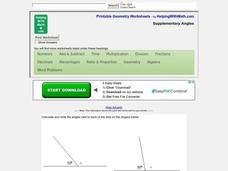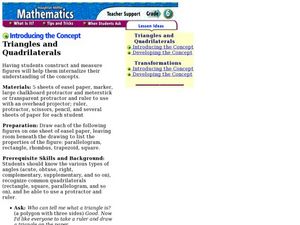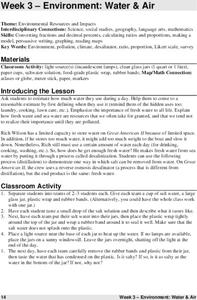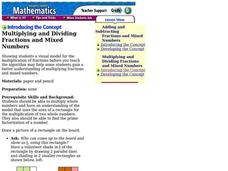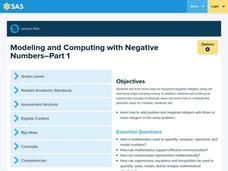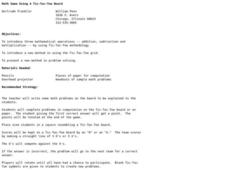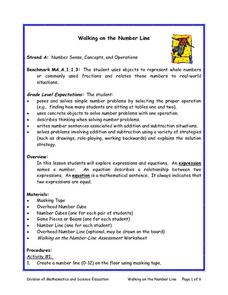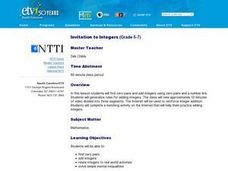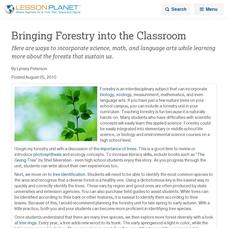Helping with Math
Supplementary Angles
Pupils calculate the measurement of supplementary angles when one angle is known. The one-page assignment has six simple problems. It contains links to related resources as well as the answer key. Be aware that although the publisher...
Curated OER
Investigation - Adrienne's Pattern Block Angles
Fifth graders investigate possible solutions to a word problem. They explore properties of polygons and right angles. Students demonstrate proper angle measurement. Students discover patterns.
Curated OER
Adding Fractions with Unlike Denominators
Students explore why denominators need to match before adding (or subtracting) a fraction. They use unmarked fraction circles and marked fraction bars, to discover a method to add fractions with unlike denominators using equivalent...
Houghton Mifflin Harcourt
Introducing the Concept: Triangles and Quadrilaterals
Guide your geometers through the process of constructing polygons. They learn how to draw triangles, squares, parallelograms, rectangles, rhombuses, and trapezoids with specified angles using a protractor and a ruler. The lesson plan...
Illustrative Mathematics
Watch out for Parentheses
It is important for the algebra learner to understand the use of parentheses. Mathematicians of all levels can make errors with nested parentheses. This will give them some practice. It makes for a good class starter or quick assessment.
Curated OER
Multiplying and Dividing Decimals
Learn to multiply with decimals. The class reviews multiplying multi-digit whole numbers based off of word problems. Then they learn how to multiply using decimals and practice with money problems.
Curated OER
Introducing the Concept: Rates
Sixth graders explore rates as a specific type of ratio, using visual examples of unit rates and unit prices to increase comprehension. They also practice solving problems that are modeled by the instructor. The well-scripted lesson plan...
Curated OER
How Much Water Do Plants Need?
Students experiment with the effects of varying amounts of water on household plants. They give different amounts of water to plants and then observe and record the effects.
Curated OER
Environment: Water & Air
The introduction to the activity mentions a sailor's limited capacity to store drinking water on his ship. Pupils then set up an overnight experiment to remove freshwater from salt water by distillation. There is a math and map activity...
Curated OER
Reality Store: How to Plan a Budget, Pay Bills, and Manage Your Money
Learners plan a budget and pay bills when they visit the "Reality Store," a series of classroom studying stations. The use of paying bills and running a class store is used to help students grasp the concept of business.
Curated OER
Mind Your Pints and Quarts: Making Sense of Liquid Measurement
Elementary and middle schoolers identify different units of liquid measurement. They use the online Visual Thesaurus to learn about the relationships between units of liquid measurement.
Curated OER
Multiplying and Dividing Fractions and Mixed Numbers
Help math learners discover how to multiply fractions and mixed numbers. They will explore visual examples of the operations. They also practice solving problems that their instructor models.
Curated OER
Electricity and Magnetism
Make oral presentations electric and magnetic! As the conclusion of the study of electricity and magnetism, class members are assigned to bring to life items or people associated with these topics. Speaking as the person or object,...
Curated OER
Dividing with Fractions
Use paper strips or models to relate division problems to division of fraction problems. Since the materials can be broken up, it helps them to show how they can complete repeated subtraction with fractions and not just whole numbers.
Curated OER
Math Game Using A Tic-Tac-Toe Board
Elementary schoolers play a math game using a Tic-Tac-Toe Board. This simple idea can be used with virtually any grade level. A team of learners are the "O's," and the other is the team of "X's." Each time a team gets a problem correct,...
Curated OER
Cylinders and Scale
Students review what a cylinder is and how a cylinder is measured. They build a variety of cylinders with different heights and radii. They compare the surface area and volume of each cylinder and discuss anything that surprises them...
Curated OER
Egyptian Hireroglyphs
Fifth graders identify the aspects of Ancient Egyptians and Heiroglyphs. They compare and contrast Egyptian Hieroglyphs with the decimal number system. Students recognize the decimal number system and compares to bases other than ten.
Curated OER
Walking On The Number Line
Students investigate the concepts of expressions and equations while defining the similarities and differences. They explore the operations by using a number line and record answers while working with the teacher. Students play the game...
Curated OER
Invitation To Integers
Students find zero pairs and add integers using zero pairs and a number line. They generalize rules for adding integers. The class view approximately 10 minutes of video divided into three segments.
Curated OER
Invitation to Integers
Students find zero pairs and add integers using zero pairs and a number line. They generalize rules for adding integers. Students complete a matching activity on the Internet that helps them practice adding integers.
Curated OER
Let's Go To Mexico
Young scholars are able to use the Internet to conduct research. They research Mexican culture and traditions. Students compare and contrast Mexican and U.S. food and clothing. They convert United States currency to Mexican pesos. ...
Curated OER
The Five Number Game
Students explain what it means to square numbers. They explain what it means to cube numbers. Students define prime numbers using their own language. They are introduced to the problem by playing one game as a class.
Curated OER
Graphing
Students collect data to create different types of graphs-line, pie, and bar graphs. They use StarOffice 6.0 to create graphs.
Curated OER
Bringing Forestry into the Classroom
Here are ways to incorporate science, math, and language arts while learning more about the forests that sustain us.
